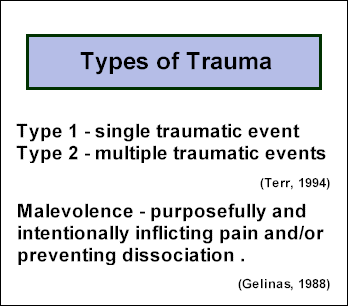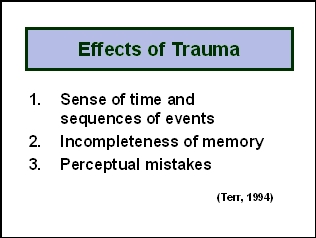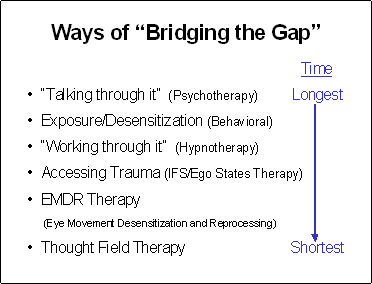Neurobiology of Trauma
and Treatment |
James
Kowal, M.S., LCPC |
6. DISTORTIONS IN THE
MEMORY OF TRAUMATIC EVENTS
TREATMENT and CONCLUSION |
|
|
|
Distortions
in the memory of traumatic events can be explained by our neurobiological model of memory.
Lenore Terr (a child psychiatrist in San Francisco), defines two types of trauma. The
trauma explored to this point is type 1, a single traumatic event. A type 2 trauma
involves multiple traumatic events in a relatively short period of time. This is a more
complex situation neurologically, particularly when the traumas occur during the
developmental period of a child’s life. Still, the model being presented can be
extrapolated to explain the type of behaviors and beliefs that arise from multiple
traumatizations. |
 |
|
|
A third type of trauma is
characterized by malevolent abuse (Gelinas,1988). This type of trauma has a particularly
significant impact on the NMS since the victim cannot rationalize or form any type of
understanding of the experience. It is also the basis of a more complex relationship in
the victim’s HMS and NMS memory systems and is notoriously difficult to treat. |
|
Terr (1994)
outlines three of the most common mistakes people make in recalling traumatic incidents
from memory. Our neurological model will make it easier to account for these three common
mistakes in remembering traumatic events. |
 |
|
|
After witnessing a traumatic event, such as a serious accident and
the consequences that follow, when people try to recall and relate the event to another
person, they often get pieces out of sequence. This is because, as they were processing
the event, the amygdala was firing off with different intensities, causing the segments of
memory to be discontinuous and stored in different areas. Upon recall, the HMS tries to
piece the segments back together, but it can easily get the segments out of order.
The second most common error in recalling a traumatic incident is
leaving a part out of the recalled scenario. An important part of the experience cannot be
recalled, often a part that had a more intense charge as the event was witnessed. Again,
this is explained by the discontinuous storage of different parts of the memory. In
reconstructing the event, the HMS fails to retrieve a piece that is particularly charged
and thus stored away from other parts of the memory.
The third kind of error involves a misperception about what was
witnessed. This is not a storage problem, but an encoding problem. The stress of trauma
opens us to a number of perceptual distortions. In addition, perception always involves
filters, sometimes called cognitive schemas or paradigms—preconceived ways of
understanding the world and characteristic ways of distorting it. When there is a
difference between what we perceive and what we believe, this "cognitive
dissonance" frequently results in an interpretation that fits our world view more
closely than it fits the experience.
|
|
|

|
|
Depending on the nature of
the trauma and several other factors described below, a client’s defense mechanisms
may be more or less structured, complex, and effective in diverting energy away from the
"hurt spot." But if therapy is to help a client resolve the effects of trauma,
the opposite must occur. The energy must travel down the fragmented memory segment, the
anxiety tolerated, the "hurt spot" activated, and the resultant memories and
emotions processed. Then the fragmented memory segment and the affect it holds can be
integrated rather than defended against. In short, the gap must be bridged. This may be
accomplished in any number of ways, with some being more efficient and more effective than
others. |
|
|
|
|
Traditional talk therapy
can lead to the gap becoming bridged, but at least two factors make it less effective than
other methods. First a tremendous amount of trust must be established for the client to
move through the anxiety barrier and enter the state of mind that can access a traumatic
memory. Second, since talk tends to activate cerebral activity and the action for
trauma work is in the limbic system, talk therapy may be a long |
 |
|
road that never gets to
the desired destination. Nonetheless, talk is the medium of the therapeutic relationship,
and Carl Rogers’ (1951) emphasis on empathic listening, unconditional positive
regard, and acceptance remains essential in building trust, regardless of the clinical
approach. |
|
Behaviorally-oriented
psychotherapy uses exposure and desensitization, where the traumatic situation and related
events are enacted or imagined in hopes of desensitizing the person. In the terms we have
been using, desensitization occurs when the gap in the memory trace is bridged and the
traumatic memory segment is discharged of its emotional valance. This can, however, be a
long and painful process. |
|
 |
In
Cognitive-Behavioral Therapy, the cognitive beliefs that were drawn from the traumatic
events the patient experienced are reframed and the associated behaviors are targeted for
change. Elements of this approach are particularly useful in curving some of the
dysfunctional behaviors that are the consequences of trauma. |
|
|
Hypnotherapists (e.g.,
Brown & Fromm, 1986) have had success inducing trance states to help patients recall
traumatic memories. The heightened internal awareness generated by hypnosis allows memory
fragments that could not be accessed to become available, and this can be done in a gentle
and controlled manner due to the phenomenon of "trance logic." The impact of the
memory can, for instance, be modulated by keeping the patient behind a
hypnotically-induced protective shield or by viewing the event from a distance. These
methods reduce and control the affective discharge that accessing the traumatic segment of
memory may cause. While hypnosis can increase the amount a person remembers, it does not
necessarily increase the accuracy of memory (Brown, Scheflin & Hammond, 1998). |
|
Ego-State (Watkins &
Watkins, 1997) and Internal Family Systems Therapy (Schwartz, 1995; Goulding &
Schwartz, 1995) work by exploring and dealing with the internalization of negative
messages that were derived from the traumatic experience(s). They both offer a gentle
approach in resolving the fear and anxiety associated with the sequelae of trauma.
EMDR (Shapiro, 2001; Shapiro & Forrest, 1997) is one of the most
significant clinical breakthroughs for processing trauma. It seems to simulate REM sleep,
the body’s natural mechanism for resolving and repairing memory segmentation. Through
EMDR, the gaps in traumatic memory segments are bridged, and the strong affect held in
traumatic memory segments is discharged. EMDR also seems to be able to
"paralyze" the defense mechanisms that prevent energy from bridging across the
"hurt spot" to the traumatic memory segment. In the neurobiological theory
described here, this should effectively resolve the trauma, and clinical experience and a
reasonable body of research evidence suggests that the symptoms of trauma often subside
rapidly with this technique.
Energy psychology, which includes Thought Field Therapy (Callahan,
1996, 2001) and its derivations (e.g., Gallo, 2000), is the newest and perhaps most
promising entry in the treatment of trauma. As described earlier, every memory path is
believed to have a corresponding thought field. When the memory path contains a "hurt
spot" resulting from trauma, the thought field contains a corresponding disturbance
or "perturbation." The techniques used in energy psychology work to resolve the
symptoms of past trauma by eliminating the perturbation in the thought field. Since an
isomorphism (one-for-one mapping) is believed to exist between a perturbation and the
"hurt spot" where the memory trace was fragmented, by eliminating the
perturbation, the break in the neuropath is quickly and effectively repaired. Energy can
then flow normally through the neurostructure, resulting in the rapid amelioration of the
symptoms of trauma.
Rapid cures for the symptoms of single-incident trauma have frequently
been reported in the literature of EMDR and energy psychology. However, regardless of the
approach used, or its power, in instances involving multiple trauma, where the Neocortical
Memory System plays a more decisive role and the memory structures are more complex, the
same safeguards that more conventional therapies use with people who have been severely
damaged need to be in place. |
|
|
|
|
Therapists find themselves
in challenging times when working with victims of psychological trauma. We have never been
called upon to treat more trauma or more severe trauma; at the same time, never before
have we had such potent tools for rising to these challenges. Much of the information
presented here builds on the work of others (See Horowitz, 1999; van der Kolk, 1987, 1996;
van der Kolk et al, 1996; Stickgold, 1998; LeDoux, 1992, 1996), and the model, while
speculative, is consistent with a growing body of research on the neurobiology of trauma.
For me, however, the significance of the model is its explanatory power. When I use this
model to think through or revise a treatment plan, or to explain to patients why they are
experiencing what they are experiencing, or to help a patient understand the treatment
approach being administered, or to engender hope in a new patient who has been suffering
for years despite various failed treatment attempts, patients get better. That is the
reason for the model, and it is the reason I am pleased to have had this opportunity to
share it with you. |
|
|
|
|
 |
 |
|
 |
 |
|
|